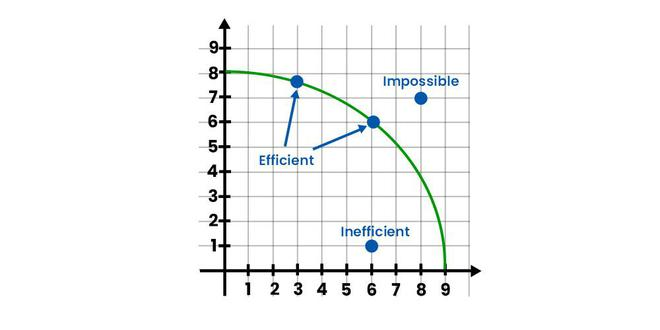Ch 2 - Discipline of Economics
(Microeconomics)
@@What is Economics?@@
^^Economics^^ in general is a study of how an entity, whether it be an individual or an organization, manages and allocates its resources in the most efficient way possible.
- It is a social science, aimed to study how resources are used and is often concerned with how resources can be used to their fullest potential.
- The need to allocate and organize resources is derived from the basic concept of scarcity which exists. This doesn’t just apply to money management, politics, or the stock market
Examples: A student who has 24 hours to spend, has to allocate his time properly (spending time with family, time for eating, time for sleeping, etc.) to make the most out of his day.
- In this example, time becomes the resource to be managed.
The ^^economic problem^^ states however that our needs our unlimited and as mentioned earlier, the resources available are scarce.
- Using the above example, the boy would have to decide how much time he allocates to all his activities in a day because he has limited time (24 hours only).
- In the realm of economics, all resources around us are considered to be limited; even the most basic things which exist around us like air or water
@@Macroeconomics vs Microeconomics@@
- ^^Macroeconomics^^: with macroeconomics, we consider the big picture- the nation’s economy as a whole.
- E.g. would changes to the money supply have an effect on country A’s imports and export?
- ^^Microeconomics^^: microeconomics filters our scope to individuals in an economy while keeping the overall economy in mind.
- Focus is directed at the roles households and firms play and how their decision-making and allocation of resources impact the overall economy. E.g. What impact would changes in interest bring towards the savings of family A?
@@Positive vs Normative Economics@@
- ^^Positive Economics:^^ this approach to economics is based on facts and figures.
- Theories to understand behavior are proved via a full procedure of hypothesis and testing. E.g. Increase in income for family A, increases their spending but not by the same amount as the change in income
- ^^Normative Economics:^^ this approach to economics is based on assumptions.
- Economic behaviors are first analyzed and then evaluated based on the researcher’s opinion. E.g. Refurbishment schemes can cause a decrease in the prices of second-hand phones
- Both these approaches are crucial for the study of economics since economic theories are the core of our study, and theories require a hypothesis that is shaped based on what an individual feels or thinks
@@Resources@@
- In terms of economics, resources are anything that helps produce goods and services e.g. farmland, machinery, etc. In macroeconomics, resources fall under 3 categories. These are also known as factors of production
- ^^Land^^: All natural resources in general including oceans, mineral deposits, crude oil, etc.
- ^^Labor^^: All human attributes involved in a task, service, or function, that can play a role in the productivity of the process e.g. teachers, factory workers, doctors, etc.
- ^^Capital^^: A productive equipment or machinery (in economic terms only)
@@Opportunity cost@@
- ^^Opportunity cost:^^ This is the cost we forgo or sacrifice, to opt for another choice
- Formula: What one sacrifices/ What one gains
- Example: The government has to choose between building a hospital and spending on the country’s defense.
- If the government decides to build the hospital, spending on the defense of the country becomes an opportunity cost.
@@Production possibility frontier@@
^^PPC^^: Graphical representation of the best possible combination of two products a country can produce if it uses up all its resources efficiently

- Points on the curve are attainable/producible.
- Points inside/under the curve are attainable, but it would indicate that the economy is not efficient and can still produce more.
- Points above the curve are not attainable (exceeding maximum capacity), but could be in the future if measures are taken
Considering point I, the country still has the capacity to produce more of either one good or another
The curve can shift upwards or downwards respectively due to certain factors:
- Changes in the amount of resources in the economy
- This could be due to changes in the labor force because of population changes, acquirement of new territories (e.g. for farming, mining), or destruction of territories due to weather conditions, etc.
- Changes in technology and productivity
- This could be due to government schemes to help farmers for instance or could be due to the usage of inefficient production techniques, etc.
Unemployment doesn’t cause shifts in the curve because it indicates that the point of production is below the curve. A decline in unemployment would cause the point of production to move closer to the curve.
@@Law of Increasing Costs@@
- ^^The law of increasing costs^^ states that as we continue to produce more of a product, our opportunity cost tends to increase but not with same difference
- Realistically, PPC curves are not straight lines and tend to be concave shaped
- The reason for this concave shape is that certain resources are more compatible with the production of a specific good/service.
- Thus when they are used up forcefully, they are less productive-hence the higher opportunity cost arises
@@Comparative advantage@@
- ^^Comparative advantage^^ means the ability of one country/nation to produce goods/services at a lower opportunity cost than another country/nation
- ^^Absolute advantage^^ is producing goods/services more efficiently, using fewer inputs
- The term emphasizes the importance of specialization and division of labor, as it leads to productivity
